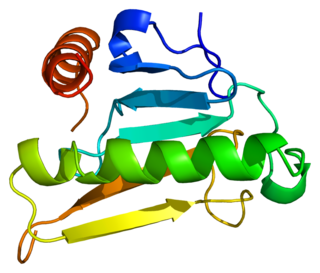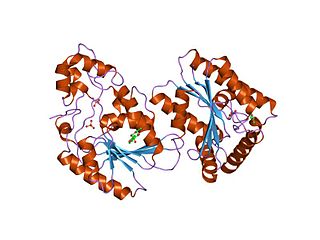
Bis(5'-adenosyl)-triphosphatase also known as fragile histidine triad protein (FHIT) is an enzyme that in humans is encoded by the FHIT gene.

Receptor-binding cancer antigen expressed on SiSo cells is a protein that in humans is encoded by the EBAG9 gene.

Cadherin-3, also known as P-Cadherin, is a protein that in humans is encoded by the CDH3 gene.

Homeobox protein Hox-A5 is a protein that in humans is encoded by the HOXA5 gene.

Centromere protein I is a protein that in humans is encoded by the CENPI gene.

Solute carrier family 35 member C2 is a protein that in humans is encoded by the SLC35C2 gene.

Melanoma-associated antigen D2 is a protein that in humans is encoded by the MAGED2 gene.

Homeobox protein Hox-C10 is a protein that in humans is encoded by the HOXC10 gene.

Condensin complex subunit 2 also known as chromosome-associated protein H (CAP-H) or non-SMC condensin I complex subunit H (NCAPH) is a protein that in humans is encoded by the NCAPH gene. CAP-H is a subunit of condensin I, a large protein complex involved in chromosome condensation. Abnormal expression of NCAPH may be linked to various types of carcinogenesis as a prognostic indicator.

Breast carcinoma amplified sequence 3, also known as BCAS3, is a protein which in humans is encoded by the BCAS3 gene. BCAS3 is a gene that is amplified and overexpressed in breast cancer cells.

CCDC186 is a protein that in humans is encoded by the CCDC186 gene The CCDC186 gene is also known as the CTCL-tumor associated antigen with accession number NM_018017.

Kallikrein-related peptidase 9 also known as KLK9 is an enzyme which in humans is encoded by the KLK9 gene.

6-phosphofructo-2-kinase/fructose-2,6-biphosphatase 4 also known as PFKFB4 is an enzyme which in humans is encoded by the PFKFB4 gene.

ZNF703 is a gene which has been linked with the development of breast cancers. ZNF703 is contained within the NET/N1z family responsible for regulation of transcription essential for developmental growth especially in the hindbrain. Normal functions performed by ZNF703 include adhesion, movement and proliferation of cells. ZNF703 directly accumulates histone deacetylases at gene promoter regions but does not bind to functional DNA.

Testis expressed 15 is a protein that in humans is encoded by the TEX15 gene.

Vexin is a protein encoded by VXN gene. VXN is found to be highly expressed in regions of the brain and spinal cord.

Chromosome 15 open reading frame 48 is a protein that in humans is encoded by the C15orf48 gene.

Augurin is a protein that in humans is encoded by the C2orf40 gene.

Chromosome 11 open reading frame 53 is a protein that in humans is encoded by the C11orf53 gene. Reduction in C11orf53 gene expression is associated with increased odds of occurrence of colorectal cancer. Specifically sequence variation (rs3802842) close to the C11orf53 gene locus that lowers the expression of C11orf53 has been observed in the colonic mucosal cells immediately adjacent to colon cancer tumors. C11orf53 downregulation aids in cells' ability to survive in acidic conditions, which are typical of the tumor microenvironment. CRISPR-Cas9 inactivation of C11orf53 in an acute myeloid leukemia cell line made the cells resistant to the BCL2 inhibitor Venetoclax, further supporting a role in cancer predisposition.

C22orf15 is a protein which, in humans, is encoded by the C22orf15 gene.


















